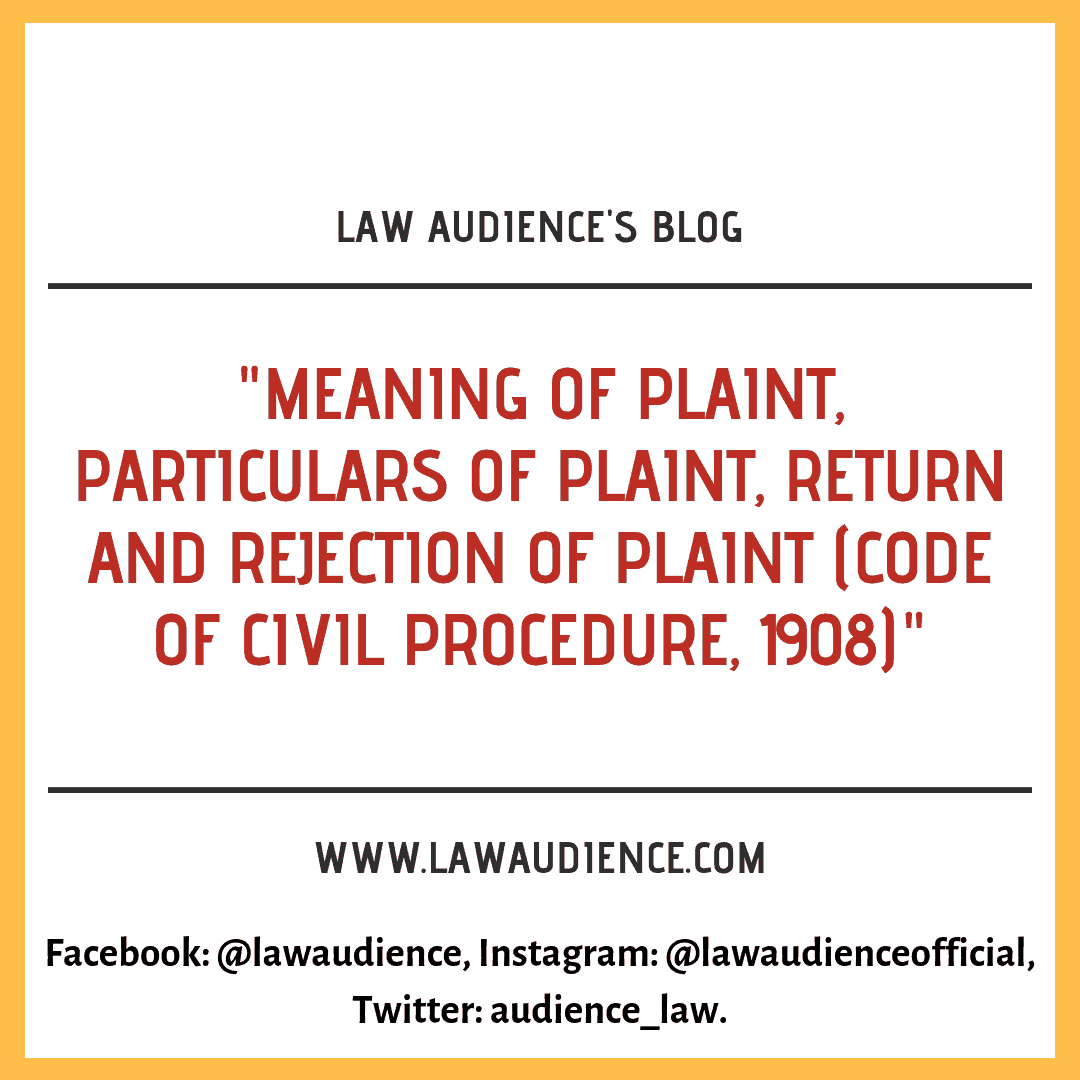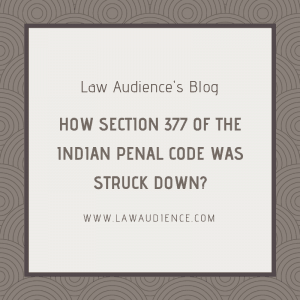AUTHORED BY: MS. NISHITA KAPOOR, B.COM.LL.B, STUDENT AT UNIVERSITY INSTITUTE OF LEGAL STUDIES, PANJAB UNIVERSITY & RESEARCH WRITER AT LAW AUDIENCE: EDITED BY MS. SONAL GUPTA, B.A.LL.B, 2ND YEAR STUDENT AT SYMBIOSIS LAW SCHOOL, HYDERABAD & ASSISTANT EDITOR AT LAW AUDIENCE.
I. MEANING OF PLAINT:
The entire machinery of the civil law is put into motion by the filing of the plaint by the plaintiff in the court of law. The meaning of “Plaint” has not been defined in the Code of Civil Procedure. Plaint essentially means the pleadings of the plaintiff. Plaint is the statement or a document in which the plaintiff put forwards his claims before the court and it is by the presentation of the plaint that the suit is instituted.
II. PARTICULARS OF PLAINT:
Order VII specifically deals with the plaint and its Rule 1-8 lay down the particulars of a plaint but in addition to this, the principles mentioned in Order VI are also applicable to it.
The four Golden Principles, which are also called the fundamental or basic rules of pleadings, are applicable to the plaint implicitly. They are;
- Only facts are to be stated and not the law.
- Only the material facts are to be stated.
- The facts should be stated in a concise and brief manner.
- No evidence should be stated.
Every plaint shall contain the following particulars:
- The name of the court in which suit is brought.[1]
- The name, description and place of residence of the plaintiff.[2]
- The name, description and place of residence of the defendant.[3]
- A statement to the effect if either party is of unsound mind or minor.[4]
- The facts constituting the cause of action.[5]
- The facts showing that the court has jurisdiction.[6]
- The relief claimed by the plaintiff.[7]
- The amount relinquished or allowed to be set off by the plaintiff.[8]
- The value of the subject matter of the suit.[9]
Other General rules to be followed while preparing a plaint are:
- Where the plaintiff sues as a representative, then the plaint shall show that the plaintiff has an actual existing interest in the subject matter and he has taken steps to enable him to institute the suit.[10]
- The defendant’s claim and liability in the subject matter are also to be stated.[11]
- It shall be specifically stated that the relief which the plaintiff claims either simply or an alternative. [12]
- The relief is in respect of several distinct claims or causes of action founded on separate and distinct grounds, shall be stated separately and distinctly.[13]
- The grounds of exemption from the limitation law after the expiration of limitation period has to be stated.[14]
As regards the Money Suits, the precise amount of the claim has to be stated and the approximate amount has to be stated when the plaintiff sues for mesne profits or for the movables in possession of the defendant or the debts of which value cannot be determined even after the exercise of due diligence.[15]
In a suit in relation to immovable property, the description of the property by which it can be identified sufficiently has to be stated. If it can be identified by boundaries or numbers in a record of settlement or survey, such boundaries or numbers shall be specified.[16]
III. RETURN OF PLAINT:
The provisions regarding the return of plaint are provided under the Rules 10, 10A, 10B of Order VII, Code of Civil Procedure, 1908. The court can return the plaint to be presented to the proper court if it finds that it does not have jurisdiction in the suit. The defect of jurisdiction can be of Territorial, Pecuniary or Subject matter.
On the returning of the plaint, the court is required to endorse on the plaint the following particulars[17]:
- Date of presentation of the plaint.
- Date of returning of the plaint.
- Name of the party which presented the plaint.
- Reasons for returning the plaint.
IV. PROCEDURE OF RETURNING THE PLAINT:
The provision under Rule 10 leaves no option for the court to dismiss the suit but only to return the plaint.[18]Where the plaint is rejected at a stage where the defendant has appeared then before returning the plaint, the plaintiff has to be intimated about the same. After receiving the intimation, the plaintiff may make an application, specifying the court in which he proposes to present the plaint, praying that the date of appearance before that court be fixed and requesting that the notice of the fixed date be given to the plaintiff and defendant. After making such application, the plaintiff is barred from appealing against such order, otherwise, the order of returning the plaint is appealable under Order XLIII Rule 1(a). Where such notice has been given it shall not be necessary for the court where the plaint is presented to serve summons to the defendant and such notice shall be deemed to be a summons for the defendant.
In the case of ONGC Ltd. v. Modern Construction and Company[19], it was held that where the plaint is presented before the court of competent jurisdiction, the plaint is to be considered as a fresh plaint and the trial is to be conducted de novo even if it stood concluded before the previous court.
V. REJECTION OF PLAINT:
a) GROUNDS OF REJECTION UNDER ORDER VII RULE 11:
The plaint can be rejected in the following cases:
- Where no cause of action is disclosed from the plaint.
- Where the plaint is undervalued and the plaintiff fails to correct it within the time fixed by the court.
- Where plaint is written on insufficient stamp paper and the plaintiff on being required by the court to supply the requisite stamp paper, fails to supply it within the time fixed by the court.
- Where the suit is barred by law as appearing from the statement in the plaint.
- Where the plaint is not filed in duplicate.
- Where the plaintiff fails to provide copies of plaint on plain paper and the requisite fees for the service of summons on the defendants within seven days of the order of the court to supply the same.
b) ADDITIONAL GROUNDS:
The above-mentioned grounds are not exhaustive in nature. There can be other additional grounds also on which the plaint can be rejected, some of its instances are:
- Where the plaint was not signed by the authorized person and the defect was not cured within the time provided, so the plaint was rejected (Radakishen v. Wali Mohammed[20]).
- Where plaint is vexatious and meritless not making out a clear right to sue, the plaint may be rejected. (T. Arivandanam v. T.V. Satyapal[21]).
An order which not involve any adjudication of the matter in dispute does not amount to the decree. But an order rejecting a plaint is treated as a decree as fiction has been created on it. In the case of Smt. Chamrain v. Mst Budhiyarin and others[22] it was held that where the plaint is rejected on grounds other than those mentioned under Order VII Rule 11 of the code then it does not amount to a decree.
The order of rejection shall be recorded along with the reasons for passing such order. The rejection of the plaint does not preclude the plaintiff from presenting a fresh plaint in respect of the same cause of action. The order rejecting plaint can be made against some of the defendants also[23].
[1] Order VII Rule 1(a), Code of Civil Procedure, 1908 (India).
[2] Order VII Rule 1(b), Code of Civil Procedure, 1908 (India).
[3] Order VII Rule 1(c), Code of Civil Procedure, 1908 (India).
[4] Order VII Rule 1(d), Code of Civil Procedure, 1908 (India).
[5] Order VII Rule 1( e), Code of Civil Procedure, 1908 (India).
[6] Order VII Rule 1(f), Code of Civil Procedure, 1908 (India).
[7] Order VII Rule 1(g), Code of Civil Procedure, 1908 (India).
[8] Order VII Rule 1(h), Code of Civil Procedure, 1908 (India).
[9]Order VII Rule 1(i), Code of Civil Procedure, 1908 (India).
[10] Order VII Rule 4, Code of Civil Procedure, 1908 (India).
[11]Order VII Rule 5, Code of Civil Procedure, 1908 (India).
[12]Order VII Rule 7, Code of Civil Procedure, 1908 (India).
[13] Order VII Rule 8, Code of Civil Procedure, 1908 (India).
[14] Order VII Rule 6, Code of Civil Procedure, 1908 (India).
[15]Order VII Rule 2, Code of Civil Procedure, 1908 (India).
[16] Order VII Rule 3, Code of Civil Procedure, 1908 (India).
[17] Order VII Rule 10(2), Code of Civil Procedure, 1908 (India).
[18] Suresh Kumar v. Maharashtra State Electricity Distribution Company Ltd., 2014 (4) Mh LJ 947 (India).
[19] (2014) 1 S.C.C. 648 (India).
[20] A.I.R. 1956 Hyd 133 (India).
[21] (1997) 4 S.C.C. 467 (India).
[22] A.I.R. 1975 M.P. 74 (India).
[23] M.V. Sea Success v. Riverpool and London Steamship Projection and Indemnity Association Ltd., A.I.R. 2002 Bombay 151 (India).



